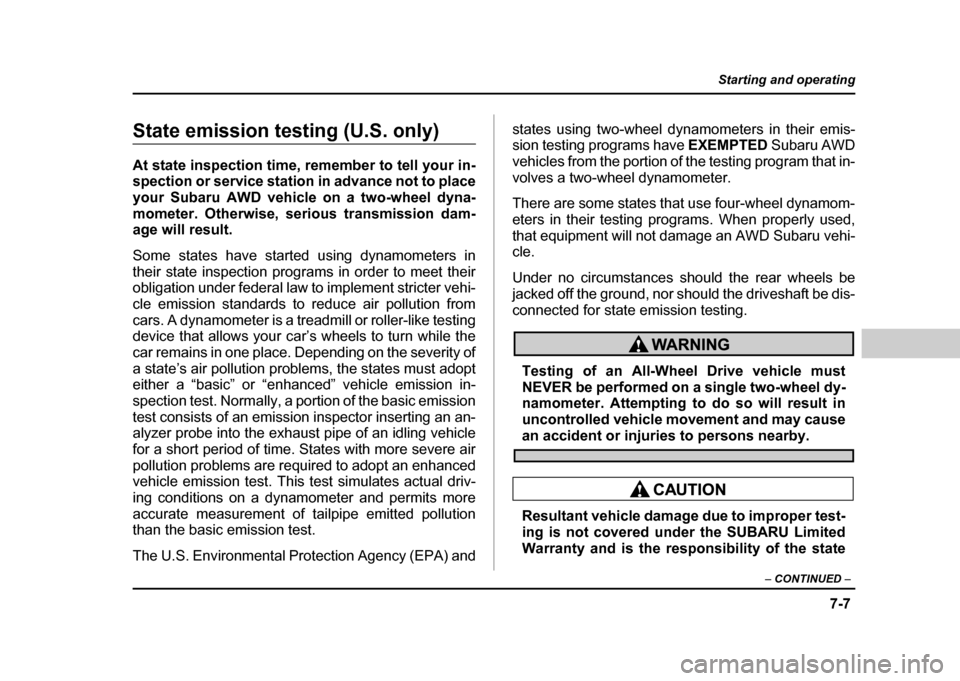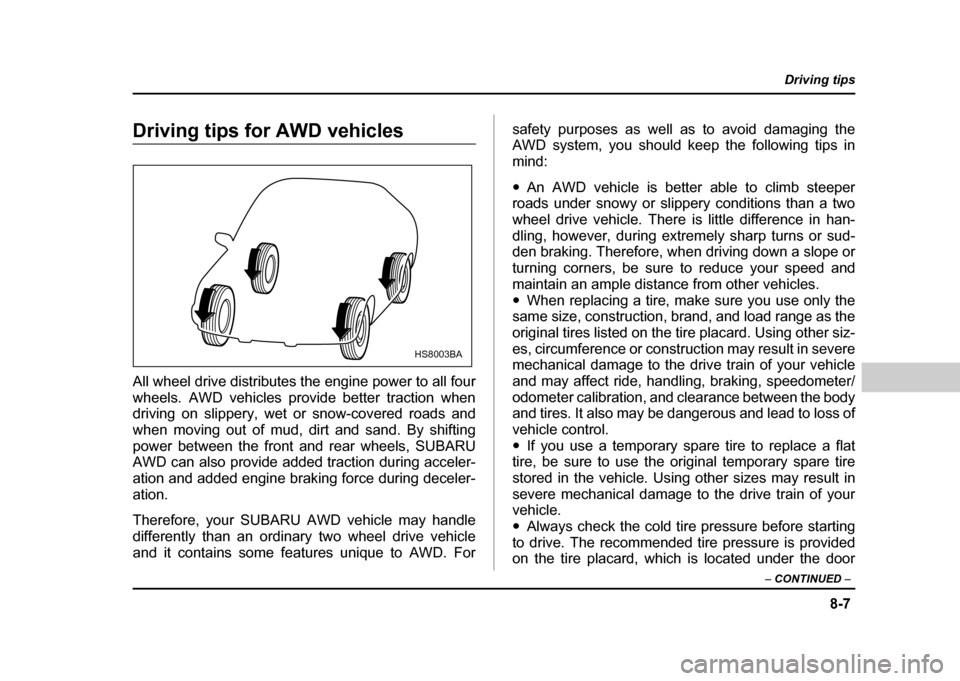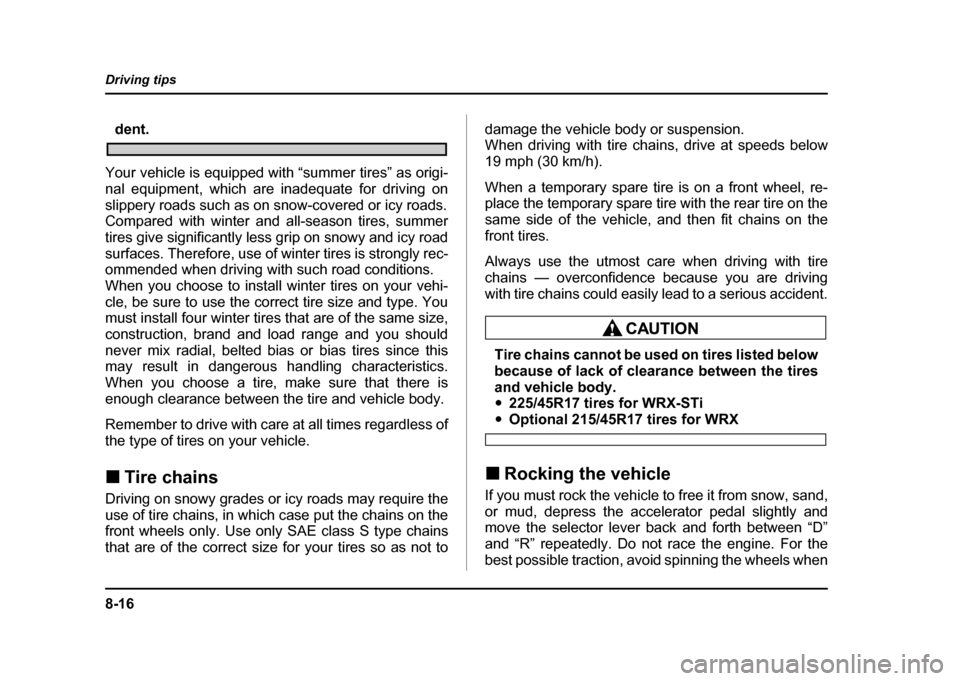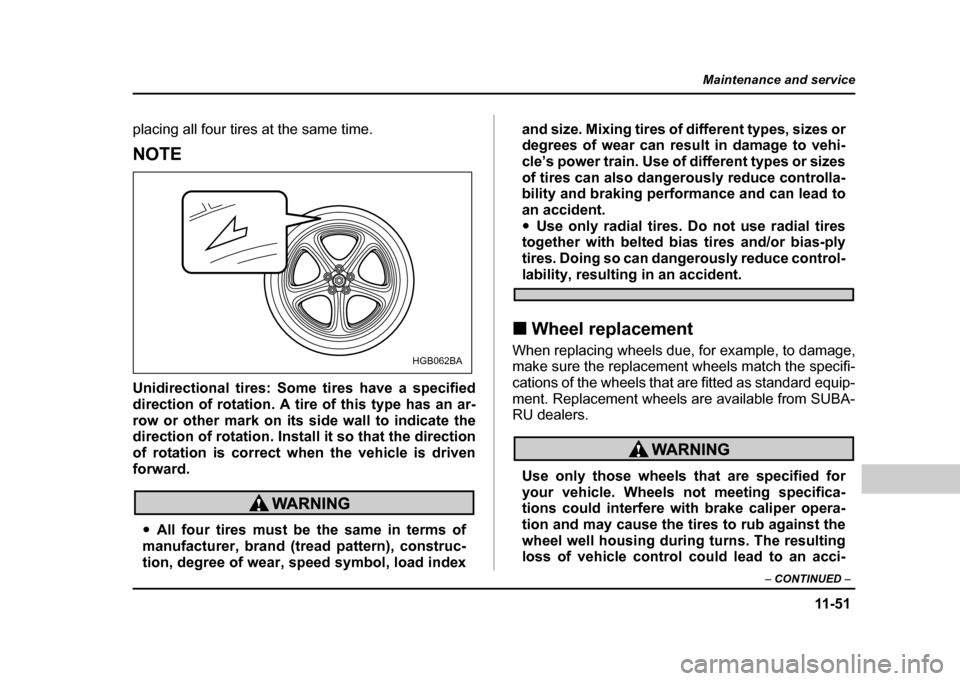2004 SUBARU IMPREZA WRX four wheel drive
[x] Cancel search: four wheel drivePage 276 of 491

7-7
Starting and operating
– CONTINUED –
State emission testing (U.S. only)
At state inspection time, remember to tell your in-
spection or service station in advance not to place
your Subaru AWD vehicle on a two-wheel dyna-
mometer. Otherwise, serious transmission dam-
age will result.
Some states have started using dynamometers in
their state inspection programs in order to meet their
obligation under federal law to implement stricter vehi-
cle emission standards to reduce air pollution from
cars. A dynamometer is a treadmill or roller-like testing
device that allows your car’s wheels to turn while the
car remains in one place. Depending on the severity of
a state’s air pollution problems, the states must adopt
either a “basic” or “enhanced” vehicle emission in-
spection test. Normally, a portion of the basic emission
test consists of an emission inspector inserting an an-
alyzer probe into the exhaust pipe of an idling vehicle
for a short period of time. States with more severe air
pollution problems are required to adopt an enhanced
vehicle emission test. This test simulates actual driv-
ing conditions on a dynamometer and permits more
accurate measurement of tailpipe emitted pollution
than the basic emission test.
The U.S. Environmental Protection Agency (EPA) and states using two-wheel dynamometers in their emis-
sion testing programs have
EXEMPTED Subaru AWD
vehicles from the portion of the testing program that in-
volves a two-wheel dynamometer.
There are some states that use four-wheel dynamom-
eters in their testing programs. When properly used,
that equipment will not damage an AWD Subaru vehi- cle.
Under no circumstances should the rear wheels be
jacked off the ground, nor should the driveshaft be dis-
connected for state emission testing.
Testing of an All-Wheel Drive vehicle must
NEVER be performed on a single two-wheel dy-
namometer. Attempting to do so will result in
uncontrolled vehicle movement and may cause
an accident or injuries to persons nearby.
Resultant vehicle damage due to improper test-
ing is not covered under the SUBARU Limited
Warranty and is the responsibility of the state
Page 318 of 491

8-7
Driving tips
– CONTINUED –
Driving tips for AWD vehicles
All wheel drive distributes the engine power to all four
wheels. AWD vehicles provide better traction when
driving on slippery, wet or snow-covered roads and
when moving out of mud, dirt and sand. By shifting
power between the front and rear wheels, SUBARU
AWD can also provide added traction during acceler-
ation and added engine braking force during deceler-
ation.
Therefore, your SUBARU AWD vehicle may handle
differently than an ordinary two wheel drive vehicle
and it contains some features unique to AWD. For safety purposes as well as to avoid damaging the
AWD system, you should keep the following tips in mind: "
An AWD vehicle is better able to climb steeper
roads under snowy or slippery conditions than a two
wheel drive vehicle. There is little difference in han-
dling, however, during extremely sharp turns or sud-
den braking. Therefore, when driving down a slope or
turning corners, be sure to reduce your speed and
maintain an ample distance from other vehicles." When replacing a tire, make sure you use only the
same size, construction, brand, and load range as the
original tires listed on the tire placard. Using other siz-
es, circumference or construction may result in severe
mechanical damage to the drive train of your vehicle
and may affect ride, handling, braking, speedometer/
odometer calibration, and clearance between the body
and tires. It also may be dangerous and lead to loss of
vehicle control." If you use a temporary spare tire to replace a flat
tire, be sure to use the original temporary spare tire
stored in the vehicle. Using other sizes may result in
severe mechanical damage to the drive train of your
vehicle. " Always check the cold tire pressure before starting
to drive. The recommended tire pressure is provided
on the tire placard, which is located under the door
HS8003BA
Page 327 of 491

8-16
Driving tips
dent.
Your vehicle is equipped with “summer tires” as origi-
nal equipment, which are inadequate for driving on
slippery roads such as on snow-covered or icy roads.
Compared with winter and all-season tires, summer
tires give significantly less grip on snowy and icy road
surfaces. Therefore, use of winter tires is strongly rec-
ommended when driving with such road conditions.
When you choose to install winter tires on your vehi-
cle, be sure to use the correct tire size and type. You
must install four winter tires that are of the same size,
construction, brand and load range and you should
never mix radial, belted bias or bias tires since this
may result in dangerous handling characteristics.
When you choose a tire, make sure that there is
enough clearance between the tire and vehicle body.
Remember to drive with care at all times regardless of
the type of tires on your vehicle. ! Tire chains
Driving on snowy grades or icy roads may require the
use of tire chains, in which case put the chains on the
front wheels only. Use only SAE class S type chains
that are of the correct size for your tires so as not to damage the vehicle body or suspension.
When driving with tire chains, drive at speeds below
19 mph (30 km/h).
When a temporary spare tire is on a front wheel, re-
place the temporary spare tire with the rear tire on the
same side of the vehicle, and then fit chains on the
front tires.
Always use the utmost care when driving with tire
chains — overconfidence because you are driving
with tire chains could easily lead to a serious accident.
Tire chains cannot be used on tires listed below
because of lack of clearance between the tires
and vehicle body. "
225/45R17 tires for WRX-STi
"Optional 215/45R17 tires for WRX
! Rocking the vehicle
If you must rock the vehicle to free it from snow, sand,
or mud, depress the accelerator pedal slightly and
move the selector lever back and forth between “D”
and “R” repeatedly. Do not race the engine. For the
best possible traction, avoid spinning the wheels when
Page 430 of 491

11 -4 5
Maintenance and service
– CONTINUED –
When installing winter tires, be sure to replace all four
tires. !Winter (snow) tires
Winter tires are best suited for driving on snow-cov-
ered and icy roads. However winter tires do not per-
form as well as summer tires and all season tires on
roads other than snow-covered and icy roads. ! Tire inspection
Check on a daily basis that the tires are free from se-
rious damage, nails, and stones. At the same time,
check the tires for abnormal wear.
Contact your SUBARU dealer immediately if you find
any problem.
NOTE " When the wheels and tires strike curbs or are
subjected to harsh treatment as when the vehicle
is driven on a rough surface, they can suffer dam-
age that cannot be seen with the naked eye. This
type of damage does not become evident until
time has passed. Try not to drive over curbs, pot-
holes or on other rough surfaces. If doing so is un-
avoidable, keep the vehicle’s speed down to a
walking pace or less, and approach the curbs as
squarely as possible. Also, make sure the tires are not pressed against the curb when you park the vehicle. "
If you feel unusual vibration while driving or find
it difficult to steer the vehicle in a straight line, one
of the tires and/or wheels may be damaged. Drive
slowly to the nearest authorized SUBARU dealer
and have the vehicle inspected. ! Tire pressures and wear
Maintaining the correct tire pressures helps to maxi-
mize the tires’ service lives and is essential for good
running performance. Check and, if necessary, adjust
the pressure of each tire (including the spare) at least
once a month (for example, during a fuel stop) and be-
fore any long journey.
Page 436 of 491

11 -5 1
Maintenance and service
– CONTINUED –
placing all four tires at the same time.
NOTE
Unidirectional tires: Some tires have a specified
direction of rotation. A tire of this type has an ar-
row or other mark on its side wall to indicate the
direction of rotation. Install it so that the direction
of rotation is correct when the vehicle is drivenforward.
"All four tires must be the same in terms of
manufacturer, brand (tread pattern), construc-
tion, degree of wear, speed symbol, load index and size. Mixing tires of different types, sizes or
degrees of wear can result in damage to vehi-
cle’s power train. Use of different types or sizes
of tires can also dangerously reduce controlla-
bility and braking performance and can lead to
an accident."
Use only radial tires. Do not use radial tires
together with belted bias tires and/or bias-ply
tires. Doing so can dangerously reduce control-
lability, resulting in an accident.
! Wheel replacement
When replacing wheels due, for example, to damage,
make sure the replacement wheels match the specifi-
cations of the wheels that are fitted as standard equip-
ment. Replacement wheels are available from SUBA-
RU dealers.
Use only those wheels that are specified for
your vehicle. Wheels not meeting specifica-
tions could interfere with brake caliper opera-
tion and may cause the tires to rub against the
wheel well housing during turns. The resulting
loss of vehicle control could lead to an acci-
HGB062BA